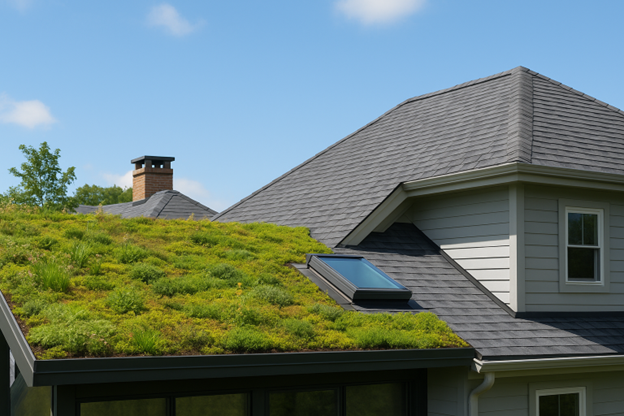Introduction
Many of you may be familiar with the movie “Set it Off,” directed by F. Gary Gray, starring Queen Latifah, Jada Pinkett Smith, Vivica A. Fox, and Kimberly Elise. There is one iconic scene where all four of them sit on the roof, looking out over the city skyline. That was a pivotal moment in the movie, and architecturally, it was a well-designed roof! An unorthodox immersive experience that allows you to see the city and be free in the moment. People often overlook a well-designed roof, but it provides comfort and protection from harsh elements during both hot summers and cold winters. We will explore how slope, ventilation, solar reflection, and insulation work together to create a “biophilic” roof system.
Roof Slope and Types: More Than Looks
Slope Matters because we want the water to be able to shed off the house. As a result, it impacts the overall shape. Each style has its own benefits and performance goals, tailored to specific locations and environments. Below are common types.
Flat Roofs: Most commonly seen in modern homes. These roofs have a minimal ¼” slope by code. It is a slight pitch to allow water to drain. It is essential to have overflow drainage nearby to prevent puddling. To have a flat roof that remains cool, pair it with reflective materials, which is critical for reducing summer heat gain.
Gable Roofs: A classic triangular shape, shedding rain and snow is easy. Their open design also allows for natural attic ventilation. A technique called Stack ventilation occurs when air enters through the eaves and escapes through the ridge, keeping the space cooler. Due to their steep angles, gable roofs can catch strong winds, making them best suited for regions with moderate weather conditions.
Hip Roofs: A traditional shape, it slopes down on all four sides, making it more stable in high-wind or hurricane-prone areas. Think of Caribbean islands, houses made of concrete often have a hip roof.
Shed Roofs: Commonly seen in contemporary designs and new home additions. The roof design is so simple that it makes the construction efficient, and when appropriately oriented, it can maximize solar panel performance or daylight exposure.
Mansard and Gambrel Roofs: These are commonly found on historic or farmhouse-style homes, which feature multiple slopes on each side, creating a distinctive appearance. It boasts a lot of character and style, but requires careful attention to insulation and waterproofing due to its complex geometry. Limited surface areas for any electrical panels. The alternative is using the new electrical shingles panels! Quite innovative, I might add.
Roof Ventilation: Letting Your Home Breathe
Meditation is a practice I do daily, so your home is no different. Without proper roof ventilation, your attic can become an oven in the summer, trapping heat that seeps into your living spaces—leaving you confused if you are indeed inside yet just as hot as outside. During winter, poor ventilation can cause condensation buildup, leading to mold (a significant health hazard) or even ice dams along the eaves.
A good roof design features both intake vents (typically located at the soffits) and exhaust vents (usually positioned at the ridge or gables). Creating a continuous airflow that removes excess heat and moisture. The house is no longer waiting to exhale.
Roof Reflectivity: The Science of Albedo and Solar Reflection
You have probably noticed that roofs have different colored surfaces, ranging from dark to light. This simple observation ties directly to a scientific concept called albedo. It is a measure of how much sunlight a surface reflects versus how much it absorbs. For example, surfaces with a high albedo, such as white, consider using shingles coated with reflective granules. It reflects a large portion of solar radiation into the atmosphere, while low-albedo surfaces, such as black, absorb more heat and radiate it downward into your home. Also, according to the U.S. Department of Energy, a properly designed cool roof can reduce roof surface temperatures by up to 50°F on a hot day.
Attic Insulation: The Hidden Hero
While ventilation helps manage airflow, insulation works to resist heat transfer between your living space and the attic. Think of it as a buffer zone. The right combination of materials, such as spray foam, fiberglass batts, or cellulose, is effective in enhancing thermal comfort and reducing utility bills.
When insulation is paired with proper ventilation and reflective materials, your roof becomes an integrated system that works year-round to maintain balance and comfort. This later becomes the platform to become a well-designed biophilic roof system.
A Biophilic Approach: Nature Roof Design
There is a growing trend of using vegetated or “green” roofs. An assembly roof component features a layered soil and plant system above the roof's waterproof membranes. These biophilic roofs help insulate your home, absorb rainwater, and reduce the urban heat island effect. It is a great way to blend into nature and bring natural greenery into any densely populated city environment. Integrating biophilic principles into roofing design transforms a functional necessity into an ecological asset. With lush rooftop gardens that attract pollinators, your roof can become a bridge between the built form and the living world.
Conclusion
We reviewed the key components of a well-designed roof. Now, upgrading to a biophilic roof is easy. Nature is a beauty to be experienced and explored. A Roof with nature becomes a living, breathing component of the building envelope that influences comfort, energy use, and your connection to the natural world. By thoughtfully combining slope, ventilation, reflectivity, and insulation, homeowners can create roofs that not only perform thermally but also support wellness and sustainability. Whether you’re building new or upgrading an existing structure, investing in a biophilic, energy-efficient roofing system pays dividends because it breathes with its environment and nurtures the people within it.
About the Author
Join the Achlab Newsletter
Get weekly insights on architecture, design law, and lifestyle — delivered straight to your inbox.
Subscribe NowBook a Consultation
Ready to bring your project to life? Get tailored guidance on home design, permitting, or construction strategy with Achlab.
- Perfect for early-stage scopes & homeowner questions



